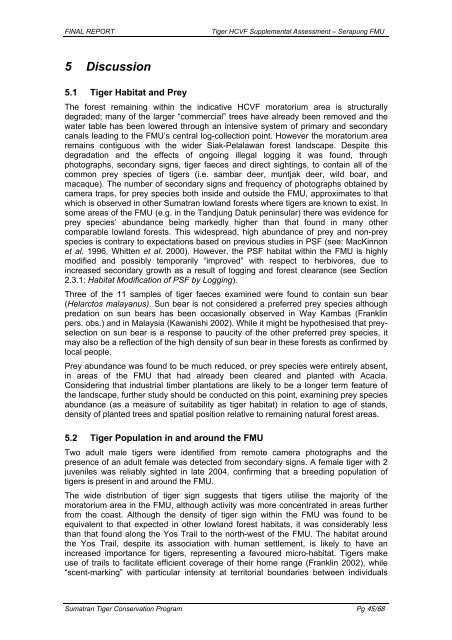A Supplemental HCVF Assessment on the Sumatran Tiger ...
A Supplemental HCVF Assessment on the Sumatran Tiger ...
A Supplemental HCVF Assessment on the Sumatran Tiger ...
Create successful ePaper yourself
Turn your PDF publications into a flip-book with our unique Google optimized e-Paper software.
FINAL REPORT <strong>Tiger</strong> <str<strong>on</strong>g>HCVF</str<strong>on</strong>g> <str<strong>on</strong>g>Supplemental</str<strong>on</strong>g> <str<strong>on</strong>g>Assessment</str<strong>on</strong>g> – Serapung FMU<br />
5 Discussi<strong>on</strong><br />
5.1 <strong>Tiger</strong> Habitat and Prey<br />
The forest remaining within <strong>the</strong> indicative <str<strong>on</strong>g>HCVF</str<strong>on</strong>g> moratorium area is structurally<br />
degraded; many of <strong>the</strong> larger “commercial” trees have already been removed and <strong>the</strong><br />
water table has been lowered through an intensive system of primary and sec<strong>on</strong>dary<br />
canals leading to <strong>the</strong> FMU’s central log-collecti<strong>on</strong> point. However <strong>the</strong> moratorium area<br />
remains c<strong>on</strong>tiguous with <strong>the</strong> wider Siak-Pelalawan forest landscape. Despite this<br />
degradati<strong>on</strong> and <strong>the</strong> effects of <strong>on</strong>going illegal logging it was found, through<br />
photographs, sec<strong>on</strong>dary signs, tiger faeces and direct sightings, to c<strong>on</strong>tain all of <strong>the</strong><br />
comm<strong>on</strong> prey species of tigers (i.e. sambar deer, muntjak deer, wild boar, and<br />
macaque). The number of sec<strong>on</strong>dary signs and frequency of photographs obtained by<br />
camera traps, for prey species both inside and outside <strong>the</strong> FMU, approximates to that<br />
which is observed in o<strong>the</strong>r <strong>Sumatran</strong> lowland forests where tigers are known to exist. In<br />
some areas of <strong>the</strong> FMU (e.g. in <strong>the</strong> Tandjung Datuk peninsular) <strong>the</strong>re was evidence for<br />
prey species’ abundance being markedly higher than that found in many o<strong>the</strong>r<br />
comparable lowland forests. This widespread, high abundance of prey and n<strong>on</strong>-prey<br />
species is c<strong>on</strong>trary to expectati<strong>on</strong>s based <strong>on</strong> previous studies in PSF (see: MacKinn<strong>on</strong><br />
et al. 1996, Whitten et al. 2000). However, <strong>the</strong> PSF habitat within <strong>the</strong> FMU is highly<br />
modified and possibly temporarily “improved” with respect to herbivores, due to<br />
increased sec<strong>on</strong>dary growth as a result of logging and forest clearance (see Secti<strong>on</strong><br />
2.3.1: Habitat Modificati<strong>on</strong> of PSF by Logging).<br />
Three of <strong>the</strong> 11 samples of tiger faeces examined were found to c<strong>on</strong>tain sun bear<br />
(Helarctos malayanus). Sun bear is not c<strong>on</strong>sidered a preferred prey species although<br />
predati<strong>on</strong> <strong>on</strong> sun bears has been occasi<strong>on</strong>ally observed in Way Kambas (Franklin<br />
pers. obs.) and in Malaysia (Kawanishi 2002). While it might be hypo<strong>the</strong>sised that preyselecti<strong>on</strong><br />
<strong>on</strong> sun bear is a resp<strong>on</strong>se to paucity of <strong>the</strong> o<strong>the</strong>r preferred prey species, it<br />
may also be a reflecti<strong>on</strong> of <strong>the</strong> high density of sun bear in <strong>the</strong>se forests as c<strong>on</strong>firmed by<br />
local people.<br />
Prey abundance was found to be much reduced, or prey species were entirely absent,<br />
in areas of <strong>the</strong> FMU that had already been cleared and planted with Acacia.<br />
C<strong>on</strong>sidering that industrial timber plantati<strong>on</strong>s are likely to be a l<strong>on</strong>ger term feature of<br />
<strong>the</strong> landscape, fur<strong>the</strong>r study should be c<strong>on</strong>ducted <strong>on</strong> this point, examining prey species<br />
abundance (as a measure of suitability as tiger habitat) in relati<strong>on</strong> to age of stands,<br />
density of planted trees and spatial positi<strong>on</strong> relative to remaining natural forest areas.<br />
5.2 <strong>Tiger</strong> Populati<strong>on</strong> in and around <strong>the</strong> FMU<br />
Two adult male tigers were identified from remote camera photographs and <strong>the</strong><br />
presence of an adult female was detected from sec<strong>on</strong>dary signs. A female tiger with 2<br />
juveniles was reliably sighted in late 2004, c<strong>on</strong>firming that a breeding populati<strong>on</strong> of<br />
tigers is present in and around <strong>the</strong> FMU.<br />
The wide distributi<strong>on</strong> of tiger sign suggests that tigers utilise <strong>the</strong> majority of <strong>the</strong><br />
moratorium area in <strong>the</strong> FMU, although activity was more c<strong>on</strong>centrated in areas fur<strong>the</strong>r<br />
from <strong>the</strong> coast. Although <strong>the</strong> density of tiger sign within <strong>the</strong> FMU was found to be<br />
equivalent to that expected in o<strong>the</strong>r lowland forest habitats, it was c<strong>on</strong>siderably less<br />
than that found al<strong>on</strong>g <strong>the</strong> Yos Trail to <strong>the</strong> north-west of <strong>the</strong> FMU. The habitat around<br />
<strong>the</strong> Yos Trail, despite its associati<strong>on</strong> with human settlement, is likely to have an<br />
increased importance for tigers, representing a favoured micro-habitat. <strong>Tiger</strong>s make<br />
use of trails to facilitate efficient coverage of <strong>the</strong>ir home range (Franklin 2002), while<br />
“scent-marking” with particular intensity at territorial boundaries between individuals<br />
<strong>Sumatran</strong> <strong>Tiger</strong> C<strong>on</strong>servati<strong>on</strong> Program Pg 45/68

















